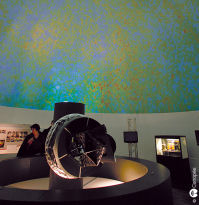Exhibition Dedicated to ESA's Planck Mission
 |
|
The Planck Dome at La Ville Européenne des Sciences. Image courtesy of Canopée
|
Outside of the dome a number of panels and interactive games explain various aspects of the project. Also on display is a full scale (1.9 by 1.5 metres) example of the primary mirror’s reflecting surface built by DTU, Denmark, in collaboration with Astrium, Germany. The Planck spacecraft’s primary reflector is made of carbon fibre reinforced plastic and consists of two face sheets with a honeycomb structure in between; it weighs just 28 kilograms, yet is rigid enough to withstand the enormous stress of launch.
Inside the Dome – through the eyes of the Planck spacecraft
 |
|
Image courtesy of Canopée |
Planck - the instruments
The Planck spacecraft will carry a payload of two highly sensitive instruments; the Low Frequency Instrument (LFI) and the High Frequency Instrument (HFI). In total, 74 detectors covering 9 frequency channels ranging from 30 to 857 Gigahertz will be used to distinguish the Cosmic Microwave Background from other sources of microwaves that lie in the foreground, such as the distant galaxies, galaxy clusters and the Milky Way.
Cooling Planck
The Cosmic Microwave Background appears to be at a temperature of around 2.7 Kelvin, however this temperature has been found to vary at a level of 1 part in 100,000. To detect and precisely measure such tiny temperature fluctuations the detectors of both Planck instruments must be cooled; to 20 Kelvin for the LFI and to 0.1 Kelvin for the HFI. This is achieved through an innovative cooling architecture that wraps around the HFI. The final, inner-most stage of this system is a dilution refrigerator that reduces the temperature of the HFI detectors to 0.1 Kelvin, just one tenth of a degree above absolute zero.
Hardware displayed at the Planck Exhibition
The Planck Dome exhibition also includes a demonstrator model of a key element of the detectors: the dilution refrigerator, developed by Alain Benoit and collaborators (Institute Neel, France). A dilution refrigerator mixes together two isotopes of helium. During the dilution a change in enthalpy occurs, which cools the helium mixture. This demonstrator was used to verify the cooling technique to be used during the Planck mission and to obtain a better understanding of the processes involved.
 |
|
Demonstrator model of the dilution refrigerator |
Complementing the demonstrator model, another highlight of the exhibition is an exact model of the dilution refrigerator that has been integrated into the Planck spacecraft, made by Air Liquide (France) in collaboration with Institute Neel and Institut d’Astrophysique Spatiale. To provide a deeper understanding of the process actually used to cool the detectors on Planck, this model has been cut to expose the system inside, which includes capillary tubes that circulate the cooled helium mixture and the platform that supports the focal plane of the HFI.
In 2001, in part as preparation for the Planck mission, an instrument, similar in design to the HFI, was flown on the first scientific flight of Archeops, a balloon-borne experiment. This experiment provided large-sky coverage of the Cosmic Microwave Background in unprecedented detail. The instrument flown was also used as a demonstrator to help develop the working principle of Planck’s HFI. A photometric pixel of this instrument, from Archeops’ focal plane, is on display inside the Planck Dome.
Planck – Looking back to the dawn of time is an initiative of François Bouchet on behalf of the French representatives in the HFI Consortium, and was created with the support of CNES, CNRS, ESA and Thales Alenia Space. During 2009 the Planck Dome will travel to a number of venues around France. Enquiries about the exposition can be directed to: contacts-resa planck.fr
planck.fr
